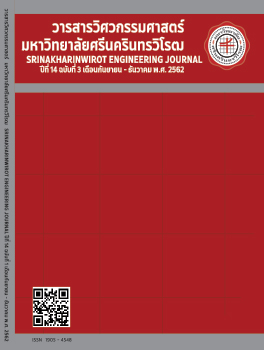Healthy Semi Automatic Grill Machine
Main Article Content
Abstract
The objective of this research aimed to develop low smoke and scent roasting food process by design and fabricate a healthy semi - automatic grill machine. The machine made by 304 stainless steel with dimension of 60 cm width, 90 cm length and 45 cm height. In the machine installed 4 sets of infrared heaters with the reflector total electrical power 2,400 W of the infrared heaters. A stainless chain conveyor with the jigs used for carrying roasted meat sticks. The chain conveyor transports meat to grill. The chain conveyor system features elliptical motion pass infrared heaters roasted meat sticks. The chain conveyor is set perpendicular to the ground and a series of infrared heaters are placed parallel to roasted meat sticks the prevent the smoke from the grill. The sticks of meat are released from the chain conveyer to the tray to distribute products after grill process. The machine used the 12 V DC motor for driving the conveyor gear 3 revolution speeds 0.32 rpm, 0.24 rpm and 0.19 rpm. The infrared heater temperature control is set at 210 - 240°C. The 5 samples of materials for testing are pork with sauce, pork with milk and sauce, pork satay, chicken and beef. The thermal efficiency depends on the size and weight of the meat. The healthy semi - automatic grill machine can make production rate 80 – 500 pieces of grill meat per hour. The average electricity consumption of the machine is 2.21 kWh. The machine can reduce energy costs by 13.4 percent compared to the use of charcoal production.
Article Details
Copyright belongs to Srinakharinwirot University Engineering Journal
References
[2] อนุชัย วรรณจิตผ่องใส, พูลศักดิ์ ฐิติเบญจพล, วรากร สิริบุณยชาติ และภาสวีร์ ผลดี, “การออกแบบและสร้างเครื่องปิ้งย่างเอนกประสงค์,”โครงงานวิศวกรรมไฟฟ้า,วิศวกรรมศาสตรบัณฑิต, วิศวกรรมศาสตร์และอุตสาหกรรมวิจัย, มหาวิทยาลัยสยาม, 2560.
[3] ธนิด ภัคธนาเดชานนท์. (2019, August 10). เตาปิ้งย่างเพื่อสุขภาพ. [Online]. Available: https://202.29.232.198/files/ 20130005_18021615150245.pdf
[4] ธีรศาสตร์ คราศร. “เตาอบย่างไก่ความร้อนจากพลังงานไฟฟ้า,” วารสารวิทยาศาสตร์และ เทคโนโลยีมหาวิทยาลัยราชภัฎอุดรธานี, ปีที่ 4 ฉบับที่ 1, 35 – 47, 2559.
[5] คมสันต์ แรงจบ และกาญจนา นาถะพินธุ. “การกระจายตัวของขนาดอนุภาคที่เกิดจากกิจกรรมประเภทปิ้งย่าง,” วารสารวิจัยสาธารณสุขศาสตร์ มหาวิทยาลัยขอนแก่น, ปีที่ 5 ฉบับที่ 2, 11 – 20, 2555.
[6] สำนักสิ่งแวดล้อม. (2019, August 10). ลดมลพิษทางอากาศจากการปิ้งย่าง...ทําได้อย่างไร. [Online]. Available: https://www.foodsanitation.bangkok. go.th/pdf.
[7] พงศ์เทพ วรรธนะเดช. (2019, August 10). Polycyclic Aromatic Hydrocarbons (PAHs). [Online]. Available:https://www.med.cmu.ac.th/dept/commed/2015/images/3153042560/7Polycyclic_Aromatic_Hydrocarbons.pdf
[8] Lawrence Gyansah, “Design, Construction and Modeling of a Mechanical Portable Barbecue Machine,” Global Journal of Researches in Engineering Mechanical and Mechanics Engineering,vol.12, pp.42–60, 2012.
[9] Muna Turkey Mossa Al-Mossawei, Abdulrazzak Abdullatif Jasim and Khalid Zemam Amer, “Reducing The Microbialled Of Chicken Meat by Improving Grill Machine Design,” Kufa Journal For Agricultural Sciences,vol10, pp.26– 45, 2018.
[10] ไพศาล นาผล, การถ่ายเทความร้อนและการระบายความร้อนอุปกรณ์อิเล็กทรอนิกส์, กรุงเทพฯ : ทริปเพิ้ล เอ็ดดูเคชั่น, 2558.
[11] สมชัย อัครทิวา และขวัญจิต วงษ์ชารี, เทอร์โมไดนามิกส์, กรุงเทพฯ : สำนักพิมพ์แมคกรอฮิล, 2554.


